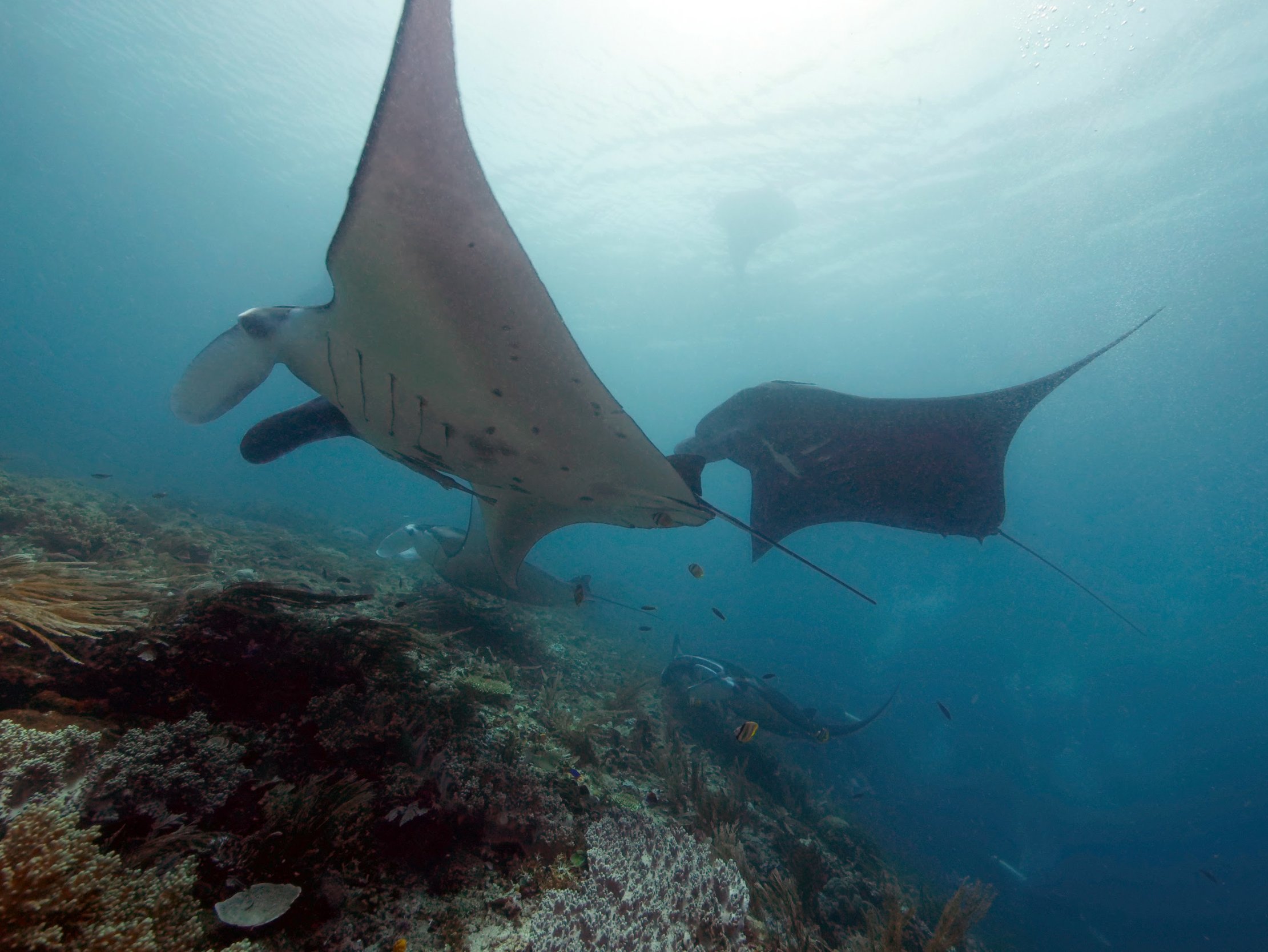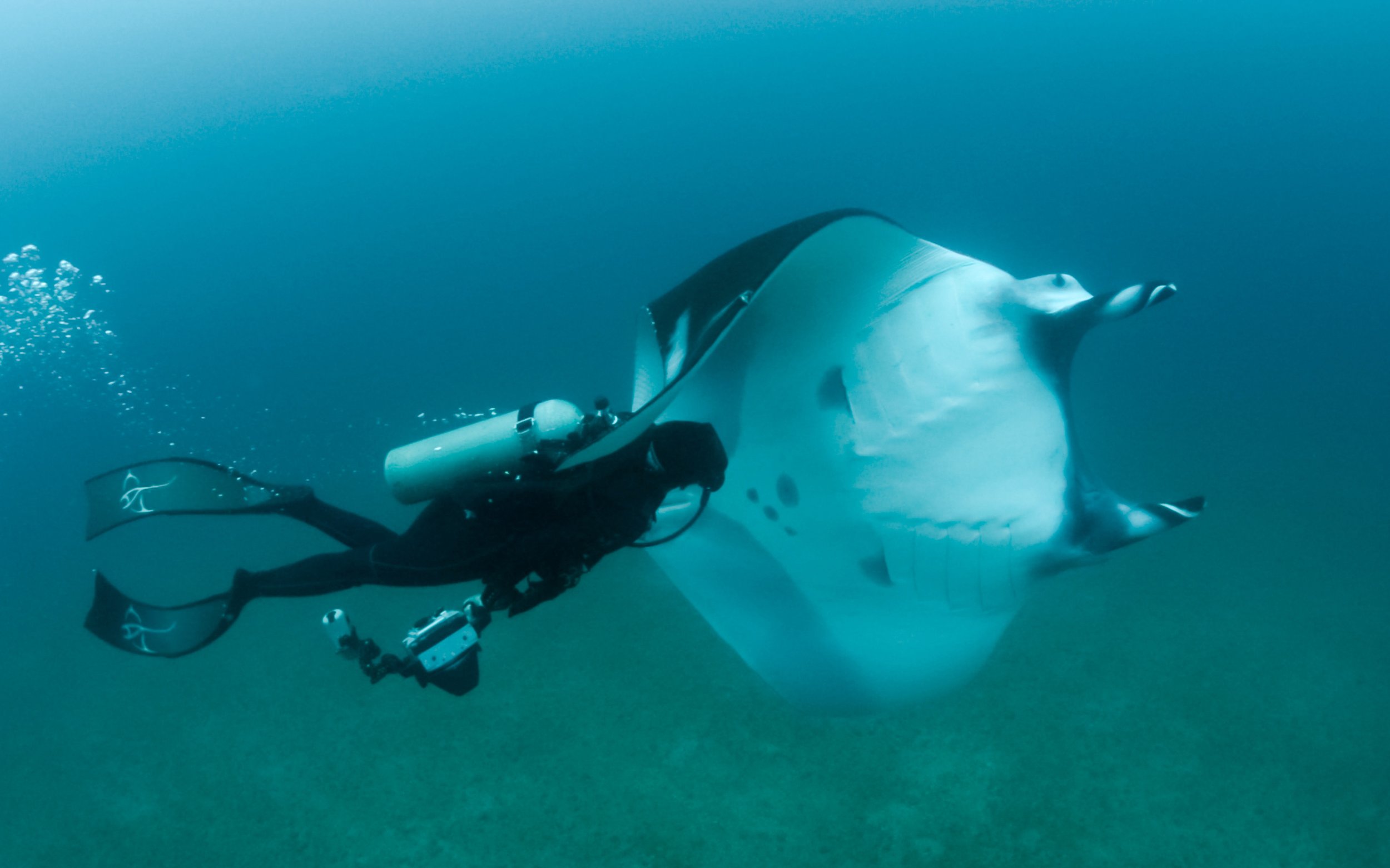New Study Shows Reef Manta Ray Social Relationships Depend on Individual Behavior Differences
Individuals with high levels of area fidelity had stronger social affiliations
Mobile individuals were important in connecting social networks
Social relations were assorted spatially into communities persisting over weeks to months
Acoustic telemetry was used to record fine-scale social dynamics in reef manta rays
Melanistic reef mantas social feeding © Rob Perryman
New research from a team of scientists from The Marine Megafauna Foundation (MMF), Macquarie University, Université de Corse, The University of Papua, University of Auckland, and the Manta Trust is revealing fresh details about their social behavior.
The study reveals that these rays regularly form social groups and that their relationships depend on individual differences in movement behavior. Published in Animal Behaviour, this research used acoustic telemetry to capture the presence of reef manta rays (Mobula alfredi) across various sites in Raja Ampat, West Papua, to better understand the dynamics of their social interactions.
The researchers tracked 27 manta rays with acoustic transmitters to find the link between their movements and social behavior. They discovered that certain individuals, groups, and locations play an important role in sustaining the integrity of a wider social network.
They found that social ‘communities’ were clearly defined by location, and that community structures remained stable over several weeks to months. The study showed that some manta rays had a stronger attachment to their physical location, and forged strong social bonds with other ‘local’ rays. Other individuals that were more nomadic moved between different communities and were important in connecting the overall social network.
Social behaviour at cleaning station Raja Ampat © Andrea-Marshall
“Manta rays seem to have quite variable behavior. They form distinct social units in shallow reef areas focused around cleaning stations, but some individuals appear to move between these areas much more frequently than others,” says Dr. Robert Perryman, lead author of the study and MMF researcher. “Mantas may have distinct social ‘personalities’ or change their social behaviors over time. Understanding manta rays’ social dynamics will help us to predict their movements, mating patterns, and responses to human impacts, all of which are crucial for supporting conservation and ecotourism.”
The study drew on more than 50,000 detections of the tagged rays at clusters of receiver stations, during several months of the peak manta ray season. “It was intriguing to track the hourly social interactions of these highly charismatic rays. Up until now, we have only had sporadic data on social groupings, so the fine-scale temporal nature of this study allows us new insight into their behavioral ecology,” said Dr. Perryman.
Social mantas © Rob Perryman
The results suggest that reef manta ray movements, habitat preferences, and social relationships are linked behavioral processes, for which knowledge of each should be combined to help protect this vulnerable species from human impacts.
“To aid conservation, it is important to know how local populations are spatially connected and the extent to which individuals interact with each other over time,” said Edy Setyawan, from the University of Auckland/the Manta Trust. “Knowledge from our study may be used to help predict impacts of human disturbance on social community structures, and on feeding, cleaning, and mating behaviors that are all highly social in manta rays. “Implementation of a strict code of conduct at every manta tourism site in the Raja Ampat region could help in minimizing this potential disturbance” Setyawan ended.
The authors would like to dedicate this article to our co-author, friend and colleague Dr. Ricardo Tapilatu, who passed away unexpectedly shortly before publication. Dr. Tapilatu was a highly respected and skilled scientist who contributed greatly to research and conservation of the marine life of West Papua, and his presence in our research team will be sadly missed.
Robert Perryman et al., (2022). Reef manta ray social dynamics depend on individual differences in behaviour. Animal Behaviour.
Notes to Editors:
For questions about this press release, please contact:
Dr. Robert Perryman – Manta Ray Scientist, Marine Megafauna Foundation
rob.perryman@marinemegafauna.org
The Marine Megafauna Foundation (MMF) was created in 2009 to research, protect, and conserve the populations of threatened marine megafauna around the world. MMF’s headquarters are located in Tofo, Mozambique, where they operate as Associação Megafauna Marinha (AMM). ‘Megafauna’ are large species such as sharks, rays, and sea turtles. For further details, please visit www.marinemegafauna.org or follow us on Twitter, Facebook, Instagram, and LinkedIn.












